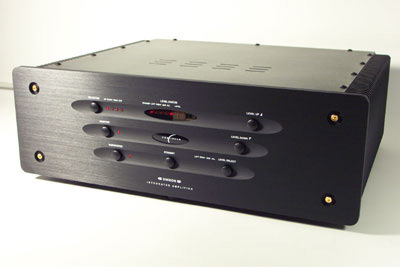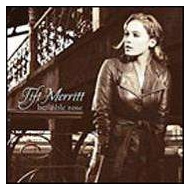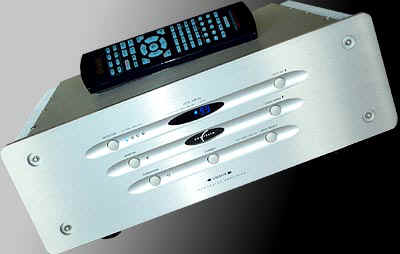You are reading the older HTML site
Positive Feedback ISSUE 9
october/november 2003
coda
Continuum Unison integrated
as reviewed by Thomas Campbell

TOM CAMPBELL'S SYSTEM LOUDSPEAKERS ELECTRONICS SOURCES CABLES ACCESSORIES
|
The Coda/Continuum Integrated Amplifier came to me at a fortuitous time. I had just moved into a new place with my fiancée, and space was at a premium. My old bachelor pad had a living room that had been laid out as a listening room, with a couple of extra components snaking to the right and left of a four-shelf rack. Though my lovely fiancée was inordinately understanding of the need to find space for my system and my huge music collection, the old arrangement of equipment just wouldn't do in the new apartment. Arriving just a couple of weeks after the move, the Unison Integrated was an instant solution.
To the majority of audiophiles who have neither a surplus of space nor a surplus of funds, integrated amplifiers are a very appealing proposition. After all, a substantial amount of the cost of a preamp or power amp goes into the design of a chassis that is both non-resonant and appropriately luxe-looking. Though the separation of power supplies between pre- and power amp tends to reward the purchaser for the extra investment with quieter and more refined performance, a well designed integrated can go a long way toward overcoming these problems. In fact, the best integrateds offer performance that rivals or beats similarly priced separates by putting the money not spent on an extra chassis into superior parts.
All this makes it surprising that the integrated market has generally not been well served by manufacturers. Most models tend to congregate around the $1000 to $1500 range. Many are solid performers, but all are middle steps up the ladder of true high end performance. There are a handful of manufacturers who make integrateds in the $7K or $8K range, and the best of these will put you in the big leagues of exalted music reproduction, but there is very little competition between the two ends of the price spectrum.
Enter the Unison. Around $3K depending on features (more on these in a moment), it's in the lower middle section of that spectrum, but there's no question that it is intended to compete directly with the big boys. I will spare you the clichéd spiel about it being "good as amps at twice the price" because the Unison is not a $3K amplifier that sounds as good as a $6K amplifier. For all intents and purposes, it is a $5K or a $6K amplifier. Utilizing a business model that is becoming increasingly popular, Coda, along with its "affordable" in-house sub-brand Continuum, is selling their wares factory direct to consumers, with no second- or third-tier markups (www.coda-continuum.com). This will not please those interested in keeping the high end dealer chain alive and well (a subject for another, much longer, article), but in every way but price—parts quality inside, parts quality outside, and most importantly, performance—the Unison is the equal of many of its more expensive competitors.
I am unfortunately compelled to spill an inordinate amount of ink explaining Unison's complicated product/pricing scheme. Showing an admirable eagerness to please but no knack for marketing, Coda makes the Unison available in a bewildering number of versions. The basic model with black or silver faceplate is $2950. The "Unison Signature," which adds a number of parts upgrades—Cardas RCAs, binding posts, and solder and Jena Labs internal wiring—goes for $3250. Finally, the "Limited Edition Unison" comes with either an all-silver finish (faceplate, top cover, heat sinks) or an eye-popping, all-gold finish, as well as a fancy, universal remote control that does everything but make dinner for you, all for $3638. The idea is that the mid-line Signature includes all the features that affect the sound, while those interested in sumptuous looks can go for the Limited Edition. The review sample was the all-silver, and I have to admit it's pretty cool, definitely the pick of the litter for me. It seems that many of the upgrades are also available a la carte, but I suggest you contact Coda directly to sort through that mess.
Hold on, though, we're just getting warmed up. The Unison is also available in Series 3.1 (100 watts per channel), 3.2 (200 watts), or 3.3 (300 watts) versions, all for the same price. I am reviewing the 100-watt version, which apparently delivers 125 watts, per some recent internal upgrades incorporated on all models. Are we confused yet? I cannot speculate on the sonic differences between the versions, as I haven't heard the 3.2 or the 3.3. I can tell you, though, that those purchasing the 3.1 will not feel cheated. The 125-watter makes use of the extra headroom by biasing higher into Class A (35 watts, as opposed to 15 and 7 for the other editions), and the results are impressive. For a more detailed technical description of the Unison, I recommend you check out Srajan Ebaen's excellent review (and follow-up) at www.6moons.com.
Lastly (I promise), Coda gives you quite a bit of wiggle room when it comes to price. You can get a 10% discount if you agree to buy it outright and forego the 14-day in-home audition period. I'm also happy to relate that you can receive a 20% discount if you mention this review if and when you call to order the Unison (though I don't reckon you can combine these offers). I was a bit wary when Coda Marketing Director Mark Ward asked me to pass on this special offer. The cynical among you may feel it smacks of some kind of unseemly collusion between audio writers and manufacturers, but I've considered it from every possible angle, and the bottom line is: Coda is apparently interested in knowing whether the process of mailing heavy, expensive samples to crazy reviewers is the worth the expense and effort, and they're figuring that for 20%, you won't forget to mention my name. That's it, folks. If I can help you save several hundred bucks on a thoroughly recommendable product, good for me, and good for you.

The Unison Integrated has most of the bells and whistles you'd expect on a amplifier in this range: subwoofer outputs, a high-quality digital volume control, and an award-winning OEM universal remote that controls all functions and can be easily programmed to do the same for your other electronics. The only possible shortcomings are the lack of a mono button (slightly surprising), and the presence of a single pair of binding posts, with no capacity for bi-wiring (quite surprising). I run single wires to my speakers, but if you have an expensive set of bi-wire speaker cables, this is fair warning. Also, the binding posts are set close to each other and, on one side, very close to the RCA connectors. I had to avoid using the RCA jacks designated for a tuner, as the spade lugs of my speaker cables were big enough to make it impossible to fit interconnects in those jacks. The Unison has RCAs for four components (CD, Tuner, Video, Aux).
If you're still with me, I'll finally describe the sound of this amplifier. The
Unison replaced my well-loved Marsh Sound Design separates (tube preamp, 100-watt power  amp), and had a lot to live
up to. The Marsh separates go for $1495 apiece, and offer incredible value for the money.
They also offer a nice apples-to-apples comparison to the Unison in terms of power and
price. After waiting a few days for the Unison to warm up in my system and for my ears to
adjust to it, I began critical listening. On such CDs as the new "RVG Series"
reissues from Blue Note (Art Blakey's Indestructible!, Dexter Gordon's Our
Man In Paris, Grant Green's Grantstand), the Unison was thrilling: fast,
deep, detailed, and dynamic as hell. With the wrong electronics, these Rudy van Gelder
remasters can sound harsh and bright, but the Unison delivered both speed and tonal
refinement. It was a shade more analytical than the Marsh combo with the tube preamp, but
the all-solid-state Unison undeniably had a firmer grip on the bass and was more even
across the frequency range. It had less "midrange magic" than the Marshes, but
was a bit more extended and neutral. These impressions held true over the first couple of
weeks of listening, as I threw numerous styles of music at it.
amp), and had a lot to live
up to. The Marsh separates go for $1495 apiece, and offer incredible value for the money.
They also offer a nice apples-to-apples comparison to the Unison in terms of power and
price. After waiting a few days for the Unison to warm up in my system and for my ears to
adjust to it, I began critical listening. On such CDs as the new "RVG Series"
reissues from Blue Note (Art Blakey's Indestructible!, Dexter Gordon's Our
Man In Paris, Grant Green's Grantstand), the Unison was thrilling: fast,
deep, detailed, and dynamic as hell. With the wrong electronics, these Rudy van Gelder
remasters can sound harsh and bright, but the Unison delivered both speed and tonal
refinement. It was a shade more analytical than the Marsh combo with the tube preamp, but
the all-solid-state Unison undeniably had a firmer grip on the bass and was more even
across the frequency range. It had less "midrange magic" than the Marshes, but
was a bit more extended and neutral. These impressions held true over the first couple of
weeks of listening, as I threw numerous styles of music at it.
Then I made a discovery. As mentioned, the volume is controlled by a digital display, which runs from 0 to 99. The same digital display can be switched to a separate balance control, with the same 0 to 99 range. If your source has a slight channel imbalance, you can trim one channel to, say, 94, while leaving the other at 99. It occurred to me that this offered a unique opportunity to control the overall gain of the amplifier, so I turned the balance of both channels down from 99 to 90, and was surprised by the qualitative difference. The Unison sounded a bit softer, as expected—I had to turn the volume up higher to achieve a certain level—but the character of the amp was also noticeably warmer and more refined, with a lower noise floor. It just seemed flat-out better, and lost the slightly analytical character I mentioned. I asked Mark Ward by email if I was crazy or if there was something to this, and this is what he said:
You may be onto something here…. There is a very reasonable explanation for what you are perceiving. The display of 99 means zero decibels of attenuation. In actuality, the preamp stage has 14 decibels of gain. If the balance is set to 85 on each channel, this eliminates the gain and turns the preamp section into a unity gain buffer…. This would explain the change in noise floor and the sonics as well.
The only difference between the preamp stage in our $3K Coda 05 preamp and the Unison is that the preamp has an additional FET buffer stage. These digitally controlled resistive ladders are generally known to sound best when operated at Unity Gain.
The rest of the reviewing period was spent with the channels balanced between 85
and 90. When set this way, the Unison seemed to me to offer the best of both
worlds—it had the power, control, and extension of top-notch solid state, as well as
the liquid midrange and tonality of well-designed tubes. To be sure, tube-o-philes may not
be  totally won
over. When it comes to certain subjective qualities, there is no question that tubes do
something special, but the solid state Unison seemed to present a downright photographic
picture of every CD and LP I played through it. The dynamics just seemed so real and so
right, the details so plentiful and nuanced, the higher frequencies extended but not
bright. The new SACD reissues of the Dylan catalog—specifically Bringing It All
Back Home, Blonde on Blonde, and John Wesley Harding—were stunning,
especially BIABB and BOB (the remaster of JWH revealed itself to be a little thin, though
still quite good). I've heard these SACDs on several systems now, and though they tend to
err just a bit towards the bright side (as do most SACD issues), the strengths and
superiority of the Super Audio format over CD are so readily apparent, it's puzzling to me
that it still cannot seem to find a foothold in the marketplace. Anyway, through the
Unison and my Harbeth speakers, I felt I was hearing the true measure of these classic
recordings and superb masterings.
totally won
over. When it comes to certain subjective qualities, there is no question that tubes do
something special, but the solid state Unison seemed to present a downright photographic
picture of every CD and LP I played through it. The dynamics just seemed so real and so
right, the details so plentiful and nuanced, the higher frequencies extended but not
bright. The new SACD reissues of the Dylan catalog—specifically Bringing It All
Back Home, Blonde on Blonde, and John Wesley Harding—were stunning,
especially BIABB and BOB (the remaster of JWH revealed itself to be a little thin, though
still quite good). I've heard these SACDs on several systems now, and though they tend to
err just a bit towards the bright side (as do most SACD issues), the strengths and
superiority of the Super Audio format over CD are so readily apparent, it's puzzling to me
that it still cannot seem to find a foothold in the marketplace. Anyway, through the
Unison and my Harbeth speakers, I felt I was hearing the true measure of these classic
recordings and superb masterings.
A new Naxos CD of Welte-Mignon Piano Rolls—etched on paper rolls decades ago by great pianists like Paderewski, Horowitz, and Levinne, but newly recorded on a restored Steinway-Welte player piano—brought these long-gone masters into my living room with palpable presence. The mic'ing is a little close here, but overall the recording is very good, and it's quite an experience to hear a new, state of the art recording of these brilliant, idiosyncratic pianists, most of which exist only on scratchy 78s. Solo piano, with its wide range and subtle dynamic shading, is an important test of any amplifier, and the Unison passed this one with flying colors: rich tone, lifelike microdynamics, and a 3-D soundstage, perhaps not as wide as through the Marsh separates, but just as deep and holographic.
For LPs, the Unison had to partner with my tubed E.A.R. 834P, and did so with
great success. The E.A.R., like most tube electronics, can be a little finicky about what
it's  paired with, but
no problems here. In fact, the pairing seemed to combine the best attributes of both
components. The Unison helped give the E.A.R. a firmer grip on the music, while the E.A.R.
gave the Unison an even richer tonal palette (not that it needed much help). The
Classic/RCA reissue of the first Brahms Piano Concerto, with Arthur Rubinstein
and Reiner/Chicago, was indescribably lush. This Rubinstein/Reiner pairing, so elegant, so
vibrant and majestic, deserves to be heard on equipment as good as this. Not to get corny,
but I had an uncanny feeling of being in the presence of greatness. On excellent rock/pop
LPs like Cat Power's You Are Free (Matador) and Tift Merritt's Bramble Rose
(Lost Highway), the Unison/E.A.R. combo was similarly beyond reproach—perfectly
balanced and live-sounding, conveying these two very different but formidable female
personalities with clarity and forcefulness.
paired with, but
no problems here. In fact, the pairing seemed to combine the best attributes of both
components. The Unison helped give the E.A.R. a firmer grip on the music, while the E.A.R.
gave the Unison an even richer tonal palette (not that it needed much help). The
Classic/RCA reissue of the first Brahms Piano Concerto, with Arthur Rubinstein
and Reiner/Chicago, was indescribably lush. This Rubinstein/Reiner pairing, so elegant, so
vibrant and majestic, deserves to be heard on equipment as good as this. Not to get corny,
but I had an uncanny feeling of being in the presence of greatness. On excellent rock/pop
LPs like Cat Power's You Are Free (Matador) and Tift Merritt's Bramble Rose
(Lost Highway), the Unison/E.A.R. combo was similarly beyond reproach—perfectly
balanced and live-sounding, conveying these two very different but formidable female
personalities with clarity and forcefulness.
There are several different kinds of audiophiles. Some, Harry Pearson-like, are obsessed with sampling the cutting edge of the state of the art, and have the funds to pursue that obsession. Some think that most of the fun of the hobby is in the frequent changing of components. But a good many of us are, first and foremost, music fans, and are primarily interested in hearing our beloved recordings reproduced as cost-feasibly as possible. For the latter camp, there are few components that are as superbly practical as the Coda/Continuum Unison Integrated. For about $3K, it is an integrated amplifier that does not need to make apologies to the best available, delivering absolutely first rate performance, and looking great doing it. What more could one ask for? Tom Campbell

Unison
integrated
Retail: $3250
Coda
Technologies/The Continuum Group
Tel: +01. 916. 383-3653
email address: [email protected]
web address: www.coda-continuum.com
